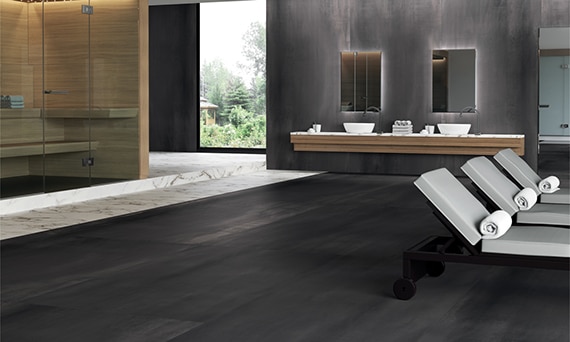
Large Format Tile Installation
Quick Tips:
• Large format tile installation requires particular attention to proper substrate preparation, grout joint sizing, trowel selection and mortar coverage.
• When installing large format tile, there must be at least 90% mortar contact and a minimum grout joint of 3/16".
• Large format tile must be installed on a level substrate.
Installation Requirement
For proper bonding, medium bed mortar should be used in installing tiles with a dimensional length greater than 20" x 20", large rectangles or tiles with greater dimensional thickness than normal.
Back buttering tiles of this nature in the installation process will also assure proper coverage for body.
STEP 1: SURFACE PREPARATION
Tile may be installed over most structurally sound substrates, if they are clean, smooth, dry and free of wax, soap scum and grease.
Any damaged, loose or uneven areas must be repaired, patched and leveled.
Remove any moldings, trim, appliances, etc., which could interfere with installation.
Door jambs may be undercut for tile to slip under.
STEP 2: LAYOUT
Begin by marking the center point of all four walls.
Snap chalk lines between the center points of opposite walls, which will intersect at the center of room. Make sure they're perfectly square, and adjust if necessary.
Next, lay out a row of loose tiles along the center lines in both directions, leaving spaces for uniform joints (use tile spacers).
Divide the room into smaller grids (approx. 2' x 3') by snapping additional lines parallel to center lines.
STEP 3: APPLYING ADHESIVE
Select the right adhesive for the substrate you're using. Carefully read and follow all instructions and precautions on the adhesive or mortar package. Mix only enough to be used within 30 minutes.
Using the type of trowel recommended on the adhesive package spread a 1/4" coat on the surface of one grid area, using the flat side of the trowel. Do not cover guidelines.
Next, use the notched side of trowel to comb adhesive into standing ridges by holding trowel at a 45-degree angle.
Then remove excess adhesive, leaving a uniform, ridged setting bed.
Don't spread a larger area than can be set in 15 minutes.
STEP 4: CUTTING TILE
Carefully measure tiles to be cut and mark with a pencil or felt-tip pen.
Make straight or diagonal cuts with a tile cutter, curved cuts with a nipper (chipping away small pieces for best results) and full-length curved cuts with a rod saw.
Sharp-cut edges may be smoothed with a carborundum stone.
STEP 5: SETTING TILE
Variation of shades is an inherent characteristic of ceramic tile – mix tiles from several cartons as you set, for a blended effect.
Begin installing tiles in the center of the room, one grid at a time. Finish each grid before moving to the next.
Start with the first tile in the corner of the grid and work outward.
Set tiles one at a time using a slight twisting motion. Don't slide tiles into place.
Insert tile spacers as each tile is set, or leave equal joints between tiles.
Fit perimeter tiles in each grid last, leaving 1/4" gap between tile and wall.
Any rectangle porcelain should never be set in a running bond pattern, rather no more than a 1/3 overlap; the joint should be widened to 3/16" and use of a large unit porcelain mortar should be employed.
When grid is completely installed, tap in all tiles with a rubber mallet or hammer and wood block to ensure a good bond and level plane.
Remove excess adhesive from joints with a putty knife and from tile with a damp sponge.
Do not walk on tiles until they are set (usually in 24 hours).
STEP 6: GROUTING JOINTS
Generally, you should wait about 24 hours before grouting (refer to the adhesive package for specifics).
Carefully read and follow all instructions and precautions on the grout package. Make only enough to use in about 30 minutes.
Remove tile spacers and spread grout on the tile surface, forcing down into joints with a rubber grout float or squeegee. Tilt the float at a 45-degree angle.
Remove excess grout from surface immediately with the edge of float. Tilt it at a 90-degree angle and scrape it diagonally across tiles.
Wait 15-20 minutes for grout to set slightly, then use a damp sponge to clean grout residue from surface and smooth the grout joints. Rinse sponge frequently and change water as needed.
Let dry until grout is hard and haze forms on tile surface, then polish with a soft cloth. Rinse again with sponge and clean water if necessary.
Wait 72 hours for heavy use.
Don't apply sealers or polishes for three weeks, and then only in accordance with manufacturer's recommendations.
Additional Resources
How to Lay Tile Patterns
A multitude of tile patterns to give your space pizzazz. Includes downloadable PDFs.
Grout for large Format Tile
Large format tile has install challenges so our experts provide these easy-to-do tips.
Extra Large Porcelain
Panoramic Porcelain Surfaces™ offers slabs larger than life and bursting with style.
One-on-one Resources
Personalized attention (& free samples!) at our showrooms to help projects go smoothly.





